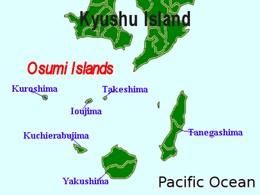Mageshima
| Native name: <span class="nickname" ">Japanese: 馬毛島 | |
|---|---|
|
Mageshima from the east | |
 | |
| Geography | |
| Location | East China Sea |
| Coordinates | 30°44′29.9″N 130°51′16.9″E / 30.741639°N 130.854694°E |
| Archipelago | Osumi Islands |
| Area | 8.2 km2 (3.2 sq mi) |
| Coastline | 16.5 km (10.25 mi) |
| Highest elevation | 71.7 m (235.2 ft) |
| Highest point | Takenokoshi |
| Administration | |
|
Japan | |
| Kagoshima Prefecture | |
| Demographics | |
| Population | -uninhabited- |
| Ethnic groups | Japanese |
Mageshima (馬毛島), is one of the Satsunan Islands, usually classed with the Ōsumi Islands belonging to Kagoshima Prefecture, Japan. It is administered by the city of Nishinoomote on Tanegashima.
Geography
Mageshima is located 12 kilometres (6.5 nmi) west of Tanegashima. The island is of volcanic origin, and has an area of approximately 8.2 square kilometres (3.2 sq mi) with a circumference of 16.5 kilometres (10.3 mi). The highest elevations on the island are Takenokoshi (岳之越), with a height of 71.7 metres (235 ft) above sea level.
The island’s climate is classified as subtropical, with a rainy season from May through September.
History
Mageshima has been occupied, at least seasonally, since the Kamakura period, as fishermen from neighboring Tanegashima would use it as a base of operations. The inhabitants were evacuated during World War II for security reasons. In 1951, an effort was made to colonize the island with government assistance, and the island population reached a peak of 528 people in 113 households in 1958. The economy of the island was based on the production of sugar cane and vinegar, as well as commercial fishing. However, difficulties with agriculture due to pests, and due to foreign completion caused many islanders to abandon the island from the late 1960s.
In 1974, the Heiwa Sogo Bank started a resort venture and floated plans for construction of the national oil reserve on the island, but neither plan came to fruition. In March 1980, the last resident left the island. In 1995, a subsidiary of Tateishi Construction acquired the island, and announced plans to construct a landing field for the Japanese space shuttle, HOPE-X, on the island. Other plans to establish a spent nuclear fuel storage facility were also announced. However, subsequently no construction has been taken and the HOPE-X project itself was cancelled in 2003. In 2009, Mageshima came under consideration as a possible relocation site for the Marine Corps Air Station Futenma in Ginowan, Okinawa, or at least as a site for the United States Navy to relocate its aircraft carrier aircraft touch-and-go training. However, Tateishi Construction subsequently came under investigation for tax fraud and for collusion with politicians over the project. Initial logging to clear an area for the proposed runways was performed without proper permission, and in September 2011 local fishermen filed lawsuits alleging damage to fishing grounds due to increased runoff created by the illegal logging.
References
- McCormack, Gavin. Resistant Islands: Okinawa Confronts Japan and the United States. Bowman & Littlefield (2012) ISBN 1442215623 -
External links
| Wikimedia Commons has media related to Mage Island. |
